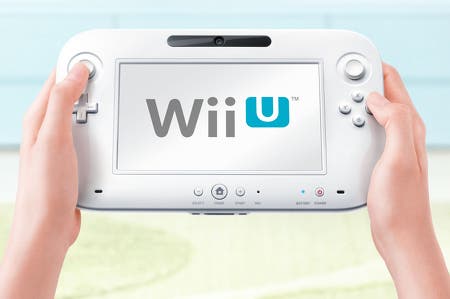Digital Foundry: Hands-On with Wii U
Forensic analysis of the big E3 titles.
Closely following its much-hyped re-unveiling at E3, the doors to a hands-on session with Nintendo's new Wii U were drawn open for a three-day spell at a recent London event. Naturally, we jumped at the chance to get up close and personal with the mysterious new hardware after an unconvincing debut at the firm's E3 press conference.
Precise details on its exact specs remain scarce, as always; the Big N's policy of guarding this information means we're unlikely to know much more than the fact it uses a tri-core IBM CPU paired with an updated derivative of an AMD graphics card. Rumours of RAM in excess of 1GB are at large too, but are still unconfirmed - that is, until we can prise a unit open of our own at some point in the future.
Until then, that ambiguity keeps things interesting. The Kyoto company's determination to steer our focus away from these technological facets and towards the magic of its software has no doubt amplified its mainstream presence.
However, it's clear that there's still much for Nintendo to prove in the realm of HD gaming. In this generation alone we've seen an unprecedented number of high-profile developers rise and fall based on their ability to adapt to current console architecture. At the risk of unweaving the rainbow that arcs over its Mushroom Kingdom, it's worth giving credit where credit's due and seeing where Nintendo stands at the minute in purely technical terms - from the hardware to the new rendering techniques it is using in its games.
Before we start, it bears mention that the company's "innovation first" tack holds true for coverage at events such as these where, no doubt to the dismay of pixel-counters everywhere, direct HDMI video feeds weren't made available on the day. We were also forbidden from snapping pictures of the HDTV frame dead-on during play - all footage had to be shot from an angle, and always keeping a player with a controller to hand in focus.
"Rayman Legends stood out as one of the most impressive Wii U titles at the event - a worthy sequel, with some great tablet-based concepts."

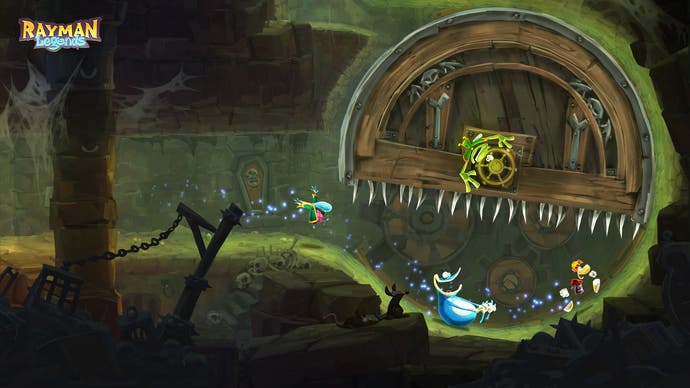
The GamePad And The Game
Fortunately, there's plenty to say based on our direct experiences with the console. The first thing we pick up on are the dimensions of the Wii U console; an essentially more curvaceous Wii with an extra 50 per cent added to its length, and two large vents to its side.
Besides the addition of an HDMI port to its rear, there are very few surprises in terms of connectivity; the standard AV, power and sensor bar connectors stand strong, although the power block remains out of sight. Ideally this would account for the extra mass added to the unit, making it an all-in-one piece of kit, but it's more likely that these early demonstrations have them hidden under the kiosk.
The second thing to note is the newly revised tablet controller (dubbed the "GamePad") lying next to it, which eschews the low-profile slide-pads as seen on the 3DS in favour of traditional, raised analogue sticks. Players familiar with the GameCube's sticks will feel right at home here, though the absence of the octagonal indents could have an impact on the way directional control works in games like Mario Galaxy. It's also remarkable for being as light as it is, considering it packs a rechargeable battery, rumble, a myriad of sensors for orientation and acceleration, plus that unmissable 6.2-inch touch-screen at its centre.
The touch-screen is based on twisted nematic (TN) LCD technology, which comes with a set of benefits and drawbacks. On the plus side, TN panels are relatively inexpensive components, light, keep pixel response snappy, and are energy efficient, but on the negative we're left with some weak viewing angles, and black levels that simply can't compare with the pricier AMOLED alternatives. In practice we find this isn't an issue for single-player use, and 480p screen is strikingly clear in games such as the Luigi's Ghost Mansion mini-game in Nintendo Land or Ubisoft's Rayman Legends.
"On the tethered development tablet we tested, we found that the controller rendered the image well ahead of the HDTV - a big surprise."
In either of these games, gameplay projected to the HDTV is typically mirrored to the smaller screen, and the high level of clarity does heavily suggest that the controller is being sent a separate framebuffer to suit its native resolution, as opposed to having the HDTV's 1280x720 output downscaled. Such additional scaling would result in a degree of blurriness, which we do find to be somewhat true of games like New Super Mario Bros. U. In this case, we notice the lower display leaves Mario looking fuzzier than he perhaps should - and certainly not as crisply rendered compared to characters in Rayman Legends. Of course, this is based on a very early demo, and quality may be subject to change.
Latency also factors into the equation when using any wireless device, and memories of the PSP's heavily buffered Remote Play feature have us hoping for a significantly reduced delay between the higher and lower screens. Fortunately, we're pleased to find that latency here is impossible to pick out without some exacting method of measure. In testing the difference, we find results that completely subvert our expectations here; in instances where gameplay is mirrored between the two, the GamePad screen actually renders the image 116ms before the 50-inch LG screen does.
This disparity must surely have its roots in some heavy post-processing on the TV side, but it speaks volumes about the fundamental responsiveness of the GamePad screen. There is the curious issue of why the tablets are wired directly to the kiosks, however, and there's no absolute certainty whether this setup is just for power, or if AV data is flowing to and from the console as well. Regardless, even in a head-to-head wired comparison, this is still surprising and rather impressive.
Pleasing Response
As demonstrated at E3, control responsiveness in its current state is spot-on when playing levels such as the rhythm-based finale to the Rayman Legends demo. Anything less would scupper the timing of Rayman's jumps between each spiked wall or crumbling ledge. While being far from conclusive (more tests would be required in better conditions), our 60Hz footage suggested something along the lines of a 66ms response in New Super Mario Bros. U - par for the course with current-gen 60FPS games.
Much of what we're seeing so far does put the GamePad functions to effective use. Among the most strikingly original is ZombiU, an exclusive first-person survival-horror shooter, which relies heavily on your switching between items in the inventory on the fly. This is achieved by dragging different weapons around the screen with your finger or stylus, and in the case of the sniper rifle, using the GamePad's gyrometer while raised to get a scoped view of your undead targets. Other games, such as Wii Fit U, give you completely alternative perspectives of the game world via the smaller screen to benefit the experience.
"Nintendo's use of the tablet controller proved to be as adept and as innovative as we expected, with third-party exclusives also demonstrating some fresh new ideas."


The Trampolining mini-game, for example, takes readings from the Wii Balance board to determine how close to its centre you're going to land for the next bounce, and lets the GamePad screen show you from a helpful birds-eye view. Meanwhile, the HDTV shows the exact height of your jump by giving you a perspective from the side. In this sense, both Wii Fit U and ZombiU prove to be highly practical uses of the technology. However, in the latter case we do find using the more conventional control systems to be cumbersome. Aiming on the analogue sticks needs addressing; we noticed a measure of input lag that feels most closely comparable to Killzone 2's "weighty" 150ms. A bit of a disappointment, and remains an issue with the Wii U Pro controller too.
Meanwhile, Project P-100 bolsters the Wii U's third-party line-up with the fluid response times expected of 60FPS. This features GamePad integration from the off; you draw shapes and lines on the touch-pad to transform your mass of units into objects like aeroplanes (to fly across gaps), chains (to climb up buildings), or swords (direct combat), and can also draw lassos to rein in more pedestrians on the streets as you progress.
We also enjoyed a sequence where one Viewtiful Joe-style hero is taken inside a building for a puzzle section, during which you use the GamePad screen to pull levers and turning cogs to impact the city outside, being shown on the HDTV. Again, image quality, latency and frame-rate appear brilliantly optimised for the small screen.
Wii U's Exclusives In The Limelight
Outside of hardware we also kept a close vigil for any improvements in graphical effects, over and above the capabilities we've previously seen from Nintendo formats. Much of the new technology in the Wii U plays to the strengths of Nintendo's beautiful, heavily art-driven visual style, but there's still plenty of room to show off some technical firepower. New rendering effects were especially apparent in games such as Pikmin 3 and ZombiU, the first of which boasted some very detailed reflections on Olimar's glass helmet, and with some impressive radiosity effects around the nursery toys in the latter demo.
In this case, we see colours on objects, like inflated beach balls and coloured crates, bleed over to nearby surfaces according to the intensity of the light. For a game like ZombiU this can be an attention-grabbing sight around indoor settings, and a break from the dank darkness of the rest of the area where the player is directing the cone of the flashlight. Dynamic shadowing works well here too, though shadows do appear a tad blocky up close.
"Pikmin and Nintendo Land demonstrated the company's approach to working with its signature artwork styles in the high-definition era."
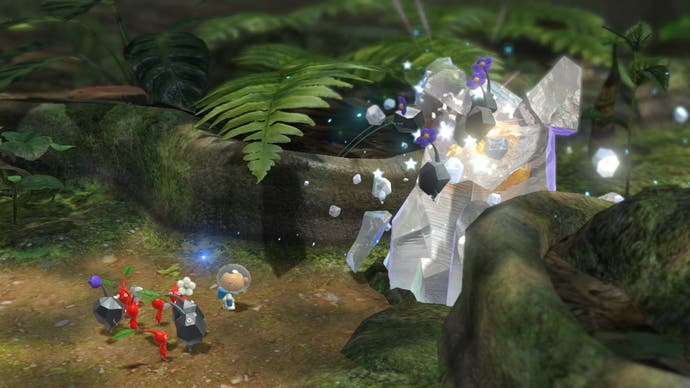
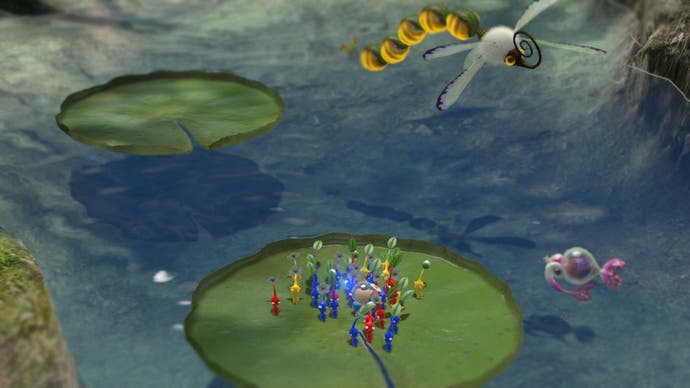
Pikmin 3 has some blurry, low-detail texturing in spots where the filtering method stands out more prominently as a result of the bump to 720p resolution. It's safe to say that this game has been in gestation for quite some time around Nintendo EAD, and development may well have roots in the original Wii hardware. The beautiful shaders used on hardened elements, such as ice on the carapace of the Centipede boss, do a good job of distracting you from the less boastful aspects of the visuals. The dewy reflections on the mushrooms and fruit your Pikmin pick up also look much more advanced than anything we've seen from a Nintendo platform, giving parts of the woodlands a delightfully sugar-coated look.
Above all, lighting is the area which has seen the greatest improvement in this generational leap. The bustling main hub area in Nintendo Land is filled with light sources, from the 3D particle effects that represent the fireworks and confetti, which each produce a vivid bloom, to the lights on the rotating carriages. Shadows move across the Mii's faces too as they wander around, adding subtle levels of depth.
Taken into the mini-games themselves, however, we see this effect being applied more practically. Streams of light can pour through windows to illuminate entire hallways in the Luigi's Ghost Mansion game, rendering the ghost player visible to the other players as they angle their own flashlights around.
Another favourite pick is Zelda Battle Quest, which lets one GamePad user take up virtual archery while four other Wii remote users wield swords. The aesthetic is very reminiscent of Kirby's Epic Yarn, where texturing for the characters and environments look like they've been knitted and stitched together, and all models benefit from a sharp jump in polygon counts. The same is true of New Super Mario Bros. U too; though many 2D elements are still used for the blocks, pipes, and rolling clouds and hills that form the parallax scroll. But here we also see Mario and the goombas are much more detailed, and coins and platforms are now rendered in full 3D.
"While flashes of true 'next-gen' rendering techniques are a little thin on the ground, Nintendo's approach to its HD visuals iss immensely appealling."


Third Party Transitions
Also present at Nintendo's event were a selection of third-party games which we've seen in some capacity before. The big-hitters set for release close to launch of the console are Batman: Arkham City Armored Edition and Ninja Gaiden 3: Razor's Edge, both of which factor GamePad features into the mix where possible.
It's worth noting that neither of these games looked particularly appealing - and certainly not the great leap over current hardware we may have been hoping for. For starters, while Armored Edition uses the GamePad screen in some briefly entertaining ways, by letting you scan an area in detective mode through its screen and switch weapons from his Bat-belt by touch, the game looks woefully unoptimised. Unreal Engine 3 relies on streaming textures, where low-resolution tiles subtly fade out for the higher-quality ones as you draw closer. Unfortunately, no big switch is occurring in the build we tried for minutes at a time, if ever.
This makes for some astoundingly blurry looking enemies and floor patterns, which prompted some passers-by at the event to question whether the Wii U unit was connected via HDMI. The hiccups to the frame-rate indicate that in this build at least, it's running unlocked, with some of the most glaring hitches popping up in front of masses of enemies. But again, this is an early build, and Batman looked suitably highly detailed and reflective.
Ninja Gaiden 3 showed minimal advantages over the existing versions of the game. The gore has been ramped up by means of decapitations, as yet unavailable on PS3 or 360, plus the increased difficulty and bundled-in DLC weapons might also tempt the series fanatic. Its GamePad functionality has less relevance to a double-dipper though, simply taking the form of lists of combos on-screen. The game runs very smoothly, with a refresh that suggests 60FPS, albeit with some slowdown when alpha-effect heavy Ninpo attacks are engaged. As such, the fights are brutal and fast, giving you no sporting chance to look down at the lists of combo strings and button presses rolling out on the small screen. It's a harmless addition that ultimately proves impractical - perhaps a little tacked on - and offers no tangible benefits over using the more familiar layout of the Wii U Pro controller.
"Ninja Gaiden 3's tablet ideas were disappointing and game performance was much the same as the PS3 and 360 versions, albeit with v-sync firmly engaged."
Otherwise, the game appears to be running fully v-synced (unlike the PS3 and 360 versions, though overall frame-rate is very similar), and with a dynamic resolution that shifts downwards obviously at moments of peak stress - a performance-saving technique that is also present in the current-gen console builds. The result ultimately boils down to some jagged edges on the finer details of Ryu's ninja suit and high-contrast elements of geometry, but outside of the rapid heat of battle this isn't too impactful.
The stellar third-party support on show from the likes Ubisoft and Platinum does give us a lot of hope for the prospects of the Wii U's starting line-up. We notice a pattern forming here, where many of the titles being made exclusively for the format seem nicely custom tailored to the capabilities of the hardware, not just in terms of using the dual-screen dynamic imposed by the GamePad, but also at a fundamental level where the console's CPU and graphics chip setup are concerned.
It remains worrying that direct ports of games currently optimised for the 360's architecture, which also boasts a tri-core IBM processor and AMD GPU, show only minor improvements or none at all. However, if the Wii U's release schedule can keep up the tempo with games like Project P-100 and Rayman Legends - both of which match Nintendo's line-up in terms of creative uses for the second screen - then it's set to have a very good run indeed.
"Ports like Batman: Arkham City and Ninja Gaiden weren't hugely impressive, but titles like Rayman Legends and P-100 demonstrated that there should be some great third party releases on Wii U."
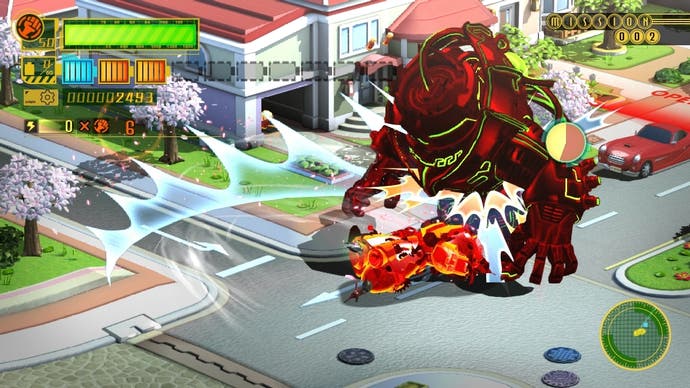

In our pre-E3 feature we asked ourselves: is Nintendo is HD ready? From what we've played here, the answer is undoubtedly yes - though perhaps more significant than the resolution bump is the extent to which games like Pikmin 3 and Nintendo Land benefit from the suite of new visual technologies at the company's disposal.
We see superior reflections and transparencies playing across the collectible fruit and mushrooms in Pikmin, and a dynamic shadow system cropping up to spectacular effect in Nintendo Land's hub-world. We even see some richly detailed fabric textures and knitted enemies in the Zelda Battle Quest mini-game that are gorgeous to look at in motion. The best part about these improvements is that they're being dealt out in the distinctly reserved fashion that characterises Nintendo, where technology continues to serve its art. Right now, it's well on its way to embellishing its games in ways we'd always hoped they would.
